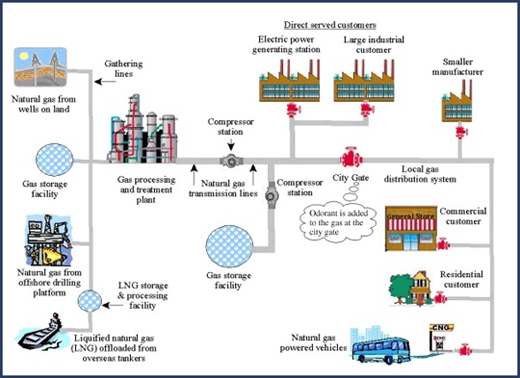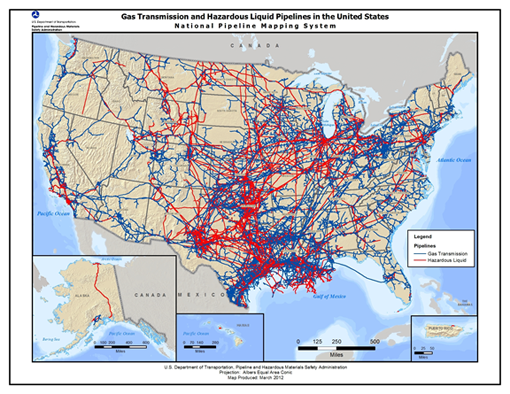
Recently the Pipeline and Hazardous Materials Safety Administration has received numerous inquiries from the public about gathering pipelines. We present the following information based upon these requests. Education and prevention are key components of pipeline safety, so in addition to learning more about gathering pipelines, the public should also remember to call 811, a nationwide toll-free number, before beginning a digging project to learn the location of pipelines that may be underground. Also visit PHMSA's State Pipeline Profiles to learn more about pipeline mileage, incident reports and the entities that regulate pipelines.
- What is a gathering pipeline?
- Who regulates gathering pipelines?
- The recent GAO report says that PHMSA has the authority to at least collect data on unregulated pipelines. Why don't you?
- What are the concerns in regard to unregulated gathering lines?
- Are gathering lines the only pipelines PHMSA regulates?
- With the increased interest in tapping natural gas in shale deposits, won't that mean MORE unregulated gathering lines?
- If regulation is eventually extended to all onshore gathering pipelines, who will be in charge of regulating them?
- What is a gathering pipeline?
Gathering pipelines transport gases and liquids from the commodity's source - like rock formations located far below the drilling site - to a processing facility, refinery or a transmission line. In the past, most gathering lines were built in minimally populated areas, used smaller-diameter pipelines that operated at lower pressures, and appeared to pose a much lower risk than for other types of pipelines. As our nation continues to grow, our populations are spreading to these once-rural locations, and an increased demand for natural resources means exploring alternate methods of producing raw materials that may come with some greater risk. Pipelines are currently still the safest means of transporting hazardous liquids and natural gas.
- Who regulates gathering pipelines?
Both the federal government and the states have jurisdiction over gathering pipelines, which is estimated to include 240,000 miles of onshore gathering pipelines. The Pipeline and Hazardous Materials Safety Administration regulates both natural gas gathering pipelines and hazardous liquid gathering pipelines.
- The recent GAO report says that PHMSA has the authority to at least collect data on unregulated pipelines. Why don't you?
We are in the process of doing just that. The Pipeline Safety Act of 1992 gave PHMSA the authority to regulate rural gas gathering lines. To exercise that authority, PHMSA had to first undergo a rulemaking process to define the terms "gathering line" and "regulated gathering line," and take into consideration certain factors in making that decision, including the operational, functional, and specific physical characteristics of those lines.
Both the definition of a gathering pipeline and the way they are employed has changed considerably since the enactment of the Pipeline Safety Act and other federal laws that regulate pipeline facilities and pipeline operators. PHMSA recognizes that the state of onshore gathering pipeline safety is evolving, and is in the process of collecting new information about gathering pipelines in an effort to better understand the risks they may now pose to people and the environment. PHMSA recently issued two advanced notices of proposed rulemaking seeking public comment on whether it should enact regulation and require data submission similar to what is currently collected on regulated gathering pipelines.
- What are the concerns in regard to unregulated gathering lines?
Most commonly reported concerns are with limited information about pipeline construction quality, maintenance practices, location and Pipeline Integrity Management.
- Are gathering lines the only pipelines PHMSA regulates?
No. PHMSA regulates more than 2.5 million miles of America's pipeline network, which includes transmission and distribution pipelines, and has been working diligently to ensure that pipelines are operating as safely as possible. Last year, PHMSA closed more than 100 enforcement cases on safety violators, the most in a single year since 2002.

The National Pipeline Mapping System - Image - With the increased interest in tapping natural gas in shale deposits, won't that mean MORE unregulated gathering lines?
PHMSA is currently considering regulating these gathering pipelines. The lines being put into service in the various shale plays like Marcellus, Utica, Barnett and Bakken are generally of much larger diameter and operating at higher pressure than traditional rural gas gathering lines, increasing the concern for safety of the environment and people near operations. Data collected about these new gathering pipelines would contribute to a body of public knowledge enabling safer and more reliable pipeline operations.
- If regulation is eventually extended to all onshore gathering pipelines, who will be in charge of regulating them?
Most onshore gathering pipelines begin and end in the same state. While PHMSA is responsible for conducting inspections on pipelines that cross state boundaries, individual states' certified pipeline safety agencies govern lines that do not. When intrastate pipelines are regulated by these agencies through adoption and enforcement of PHMSA safety standards, PHMSA's role is to oversee state agency performance. The state maintains direct regulatory authority.
